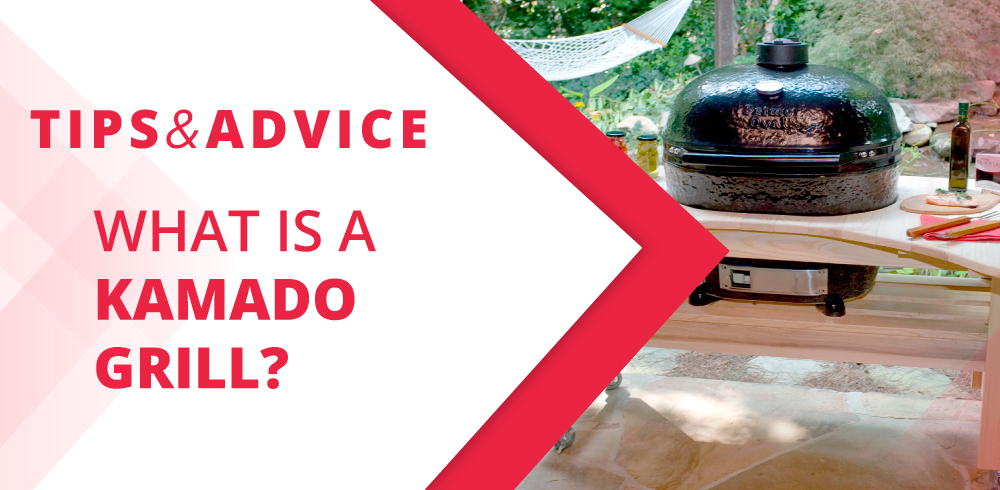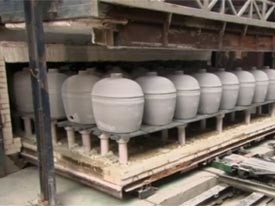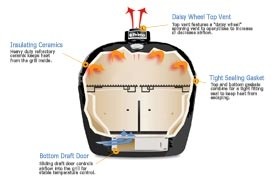
This history of the kamado grill
Kamado grills take their name from the term used to describe a traditional Japanese wood or charcoal fueled cooking appliance called a kamado. A traditional kamado was made from clay or other ceramic material to create a large urn or "egg" like vessel, similar to a tandoor, whose round shape and heavy construction allowed unique cooking benefits.
These benefits became clear for our grilling predecessors as they found the ceramic construction provided excellent insulation to keep steady temperatures even at high heat. They found that the superior insulation allows an even cooking process while also being extremely fuel efficient, reducing the amount of charcoal or wood necessary to power the appliance. In addition, the unique shape allowed for several different methods of cooking - whether baking, roasting, smoking, grilling, or any variation, the versatility of these units is unmatched.
In their modern iteration, kamado grills are built of a refractory ceramic material to ensure a high quality durability and heat retention and come in several different sizes and shapes to allow for different configurations. Several accessories and optional components can be purchased for modern kamado grills to alter the way they operate and allow for different cooking methods or distinct grilling advantages.
Heavy Duty Ceramics
As mentioned previously, most kamado grills nowadays feature a heavy-duty refractory ceramic that's been industrially designed for maximum durability and insulation. Some gas grills are made from thin metals that can't stay hot when it's cold or windy, that's not the case with kamado grills. The heavy ceramic material absorbs and radiates heat evenly back into the food which is why they make excellent pizza or bread ovens just like a professional brick oven would. What's more, much like the ancient pyramids of Egypt, the ceramic material is designed for the long haul - if properly maintained, your children will inherit your kamado grill.
Fuel-Efficient
Another direct benefit of the heavy ceramic construction is the kamado grill's fuel efficiency. Because the thick sides retain heat so well, very little charcoal and oxygen are necessary to continue to fuel the fire - perfect for long, slow cooks or diehard grillers who cook throughout the cold winter. Dampers used to control the intake and exhaust create an airflow that produces a steady flame when the lid is closed temperatures stay extremely consistent which makes the kamado an excellent choice for smoking ribs, brisket, or pulled pork at low and slow and steady temperatures.
Versatile Cooking Methods
Beyond the fuel efficiency, kamado grills have been designed to accommodate a broad spectrum of cooking methods. Accessories like a ceramic heat deflector turn a kamado from a direct grill to an indirect cooker, much like an oven or smoker. Add a firebox divider to create two distinct cooking zones for a true 2-zone setup. With various accessories and setups, a kamado grill can bake, roast, smoke, sear, saute, grill, and much more.
Important Notes About Kamado Grills
Not all kamado grills are equal. Some kamados feature higher quality construction and others still feature a better design to create a more versatile grill. Many brands feature grill carts or a wood grill table to accompany the grill while most grills have a huge line of options and accessories to enhance the grill - but aren't included with the grill by itself.
It's also very important that you never use lighter fluids or any chemical starters to light your charcoal fire. The ceramic material is porous so it can absorb the lighter fluid and can impart those flavors and chemicals into your food, in addition, it can damage the material and degrade its integrity.
Cleaning kamado grills is simple and they're easy to maintain - the most important aspect is to remember to remove the ashes after several uses to make sure the airflow isn't being disturbed or it can interfere with proper combustion.
Many kamados feature a well-designed airflow to eliminate any loss of heat; for this reason, opening a kamado grill too quickly could result in a flashover or a quick influx of oxygen that creates a rush of fuel for the fire and, poof! No more eyebrows. Always use caution when opening your kamado grill to avoid that scenario.
The Bottom Line About Kamado Grills
Kamado grills have emerged as serious contenders to be the most versatile grilling machine. Their ability to transform from high heat roaster to low, slow smoker is nothing short of delicious and is a great choice for anyone's first grill because it's such an adaptable cooker - plus they last darn-near forever.




